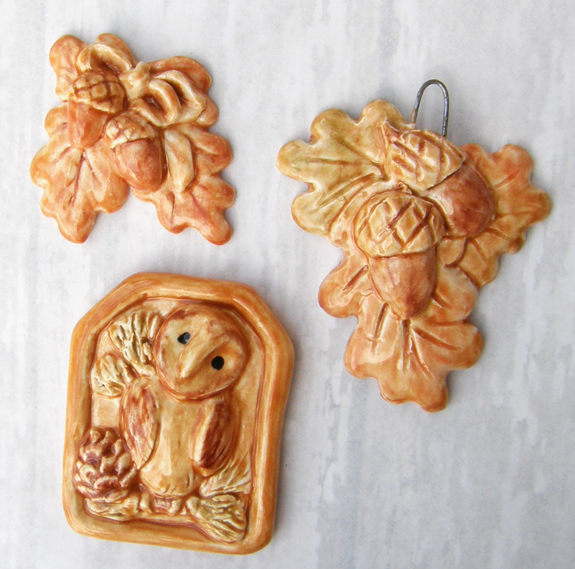Garlic Keeper: bisque at cone 04, glazed at cone 06 using Stroke and Coat glaze
I think when it come to Ceramics I would add, and also 10,000 experiments and 10,000 mistakes. I'll be sharing some of mine with you in this blog post.
Work Of Our Hands Beads made in Namibia
Reading about Mayco's Stroke and Coat ® intrigued me because it was described as sort of an underglaze, but not needing a clear coat on top.
At first the product did not seem very versatile, because it's rather thick, and takes 3 coats. I was used to underglaze which can be thinned down to act like water colors and can produce incredible detail, I didn't think I could get the effects I wanted with Stroke and Coat.
Then, I started to explore and found that it is actually extremely versatile. And indeed the "Wonder Glaze" they claim it is.
I will tell you now about my discoveries.
STENCILING OR SCREEN PRINTING:
Paint on your 3 base coats and then use a contrasting color to stencil or screen print on top of the base color.
LAYERING
On these pieces I painted 2 coats of Ivory and 1 coat of Cracker Jack Brown, then while the brown was still wet, I dabbed on some other colors,( green , dark brown, and orange) This gave me some subtle color variation.
DIMENSION
Here I painted my 3 coats of base color, then put the contrast colors in squeeze bottles. Which I got here.
It's even more dimensional if you do 2 coats of design.
WASHES
As long as you have 3 coats of base color you can thin down Stroke and Coat to a watery consistency for the last coat and wash over all or part of your piece.
PAINTERLY
Here's a combination of colors and washes
FAUX MAJOLICA
As you may know, for Majolica you paint over a glaze. With Stroke and Coat, just paint on your 3 base coats and then add your detail painting on top. For the detail painting I only used 1 coat of glaze. Note: Mayco recommends using their foundations line for the base coats, but I didn't have any so I used the Stroke and Coat® and in some instances I used transparent glaze as a base.
Cup with base coat of clear glaze and Stroke and Coat on top.
Stroke and Coat is suppose to work up to cone 6
(but they recommend firing at cone 06.) All the items above were fired at
cone 06.
Lets see how it does at cone 6:
I was very pleased with the color at cone 6
These samples have 3 coats of glaze.
Here is Stroke and Coat over cone 6 porcelain. I base coated each with clear glaze and then used 1 coat of Stroke and Coat. In some cases I like the water color look, in others not ! Worst of all, I lost my lettering at cone 6. The bottom of the bird cage said FLY.
This bowl was a real disaster. I stamped on the flower design and outlined with Mayco's Designer Liner. The Designer Liner is suppose to go to cone 6 but it also seems to spread at cone 6.
In summary and in my opinion, the glaze got an A+ at cone 06 and at cone 6 just know you will not get dimension or much detail but you should get great color.
One more detail I forgot to mention earlier, but all these pieces that I am not so happy with, can be reglazed with Stroke and Coat. I was very happy to discover that Stroke and Coat sticks very well to previously glazed beads and can give them new life !
Now I just have to see how much Stroke and Coat will fit in our suitcases and save my $ for that extra bag !
See more about our project at www.workofourhands.blogspot.com and find some of our beads at valsceramicgarden ETSY


















